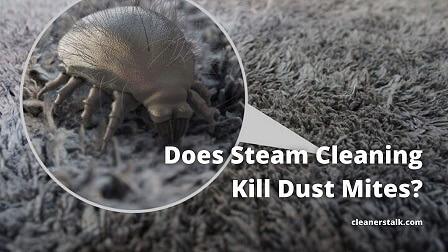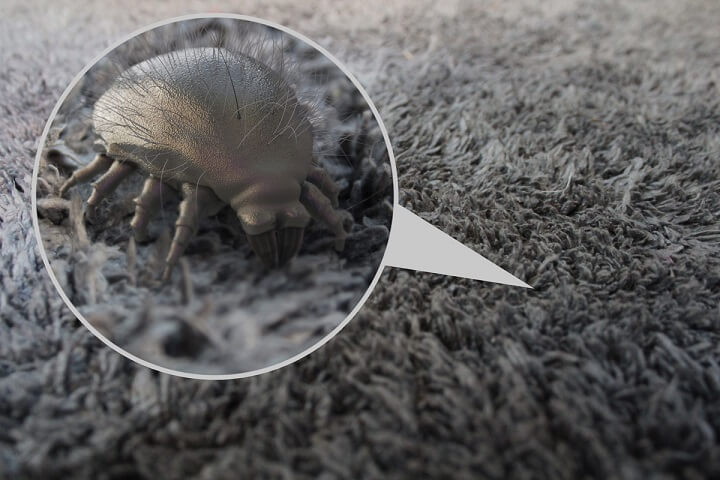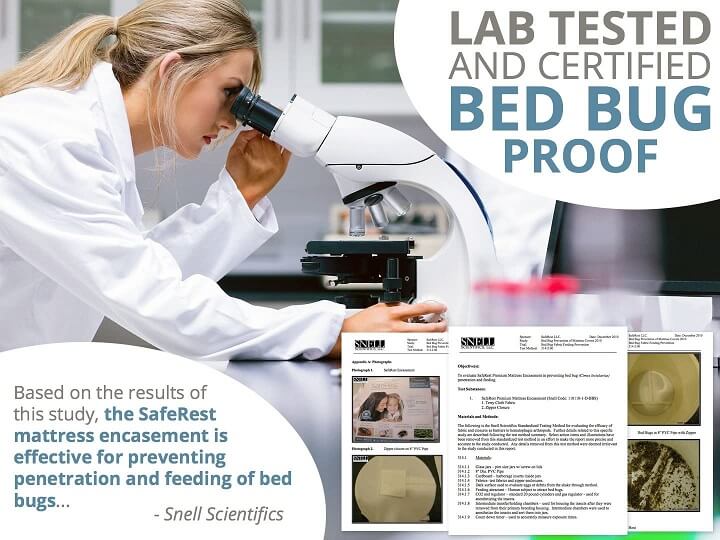
Does Steam Cleaning Kill Dust Mites?
Cleaners Talk is reader-supported. This post contains affiliate links, we may earn a commission at no additional costs to you. As an Amazon Associate we earn from qualifying purchases.
Did you know that dust mites are one of the most common allergy and asthma triggers in homes? While dust mites do not leave bites on your skin, they can cause skin rashes. This is why many are exploring different ways to effectively remove them from their homes. One of them is by steam cleaning.
Does steam cleaning kill dust mites? Steam cleaning kills dust mites and will help remove allergens. In fact, research and studies show that dust mites will die when exposed to temperatures above 130 °F. Because steam cleaners can reach this temperature, they can kill dust mites effectively.
With that said, there are important things you need to know regarding steam cleaners and dust mites. In this post, we will answer the question: does steam cleaning kill dust mites? We will also give you a simple way to recognize dust mite problems and exterminate them with the use of a steam cleaner. Let’s get started.
What Are the Signs of Dust Mites?

Dust mites are tiny, microscopic bugs which mostly feed on human or pet dead skin cells. They usually live on soft furniture and carpets. Dust mites can be difficult to detect due to their small size. While you cannot see them, they are the main cause for allergies and asthma for many people around the world.
So, how do you know if you have dust mites? Dust mites are found where dead skin cells accumulate, like bedding, furniture, and carpeting. If you have continuous allergy symptoms (sneezing, coughing, or red itchy skin) throughout the year, you may be looking at a possible dust mite allergy.
Dust mites, however, are not to be confused with bed bugs. While dust mites are microscopic creatures that resemble small bugs, they do not leave visible bites on your skin. However, an allergic reaction, caused by inhaling dust mites skin and fecal matter, may induce skin rashes. These are often red and itchy in nature.
Does Steam Cleaning Kill Dust Mites?
While you can never fully eliminate all the dust mites from your home, you can significantly reduce them by steam cleaning. The heat of the water used in steam cleaning is often high enough to kill dust mites. Additionally, steam cleaning also naturally disinfects by killing bacteria and mould spores as well.
This is backed by research as well. According to the Department of Immunology, University of Glasgow, steam cleaning has considerable potential as a highly effective and efficient method of killing and reducing concentrations of dust mites in domestic premises. The key, however, is to steam clean thoroughly.
What steam temperature kills dust mites?
So, what steam temperature kills dust mites? Temperatures above 130 °F will kill dust mites and remove allergens. To kill dust mites effectively, however, the area should be exposed with hot steam for at least 15 minutes. Steam cleaners can achieve this temperature easily.
According to the Mayo Clinic, washing sheets, blankets, pillowcases, bedcovers in hot water that is at least 130 °F will kill dust mites and remove allergens. If the bedding cannot be washed in heat, put the items in the dryer for at least 15 minutes at a temperature above 130 °F to kill the dust mites.
How to Use Steam Cleaner to Remove Dust Mites Effectively
Now that you know that steam cleaners can effectively kill dust mites, let us take a look at how to use them effectively. In addition to steam cleaning, there are other methods of dust mites treatment and prevention. Here is how to use a steam cleaner to remove dust mites from your home once and for all:
1. Steam Clean Thoroughly
If there is a dust mite infection in your home, the best way to start is to steam clean thoroughly. Steam cleaning furniture, carpets, and bedding can reduce dust mite population and lessen their growth. In fact, a study found an 87% drop of concentration of dust mites per gram of dust after carpets were steam cleaned.
PRO TIP: If you are not familiar with steam cleaning, consider reading our simple beginners’ guide on how steam cleaners work. One of their advantages is you do not need chemicals for steam cleaners to work. All you need is water. Chances are, you may be surprised at what steam cleaners can do.
2. Dust and Vacuum After
Additionally, it is important to dust and vacuum once or twice a week to remove the buildup of allergens. Because dust mites’ skin and fecal matter are the cause of the problem, you need to pick them up completely. Use a dry cloth to wipe hard surfaces such as countertops, tables, and other furniture.
When vacuuming, we recommend using a vacuum cleaner equipped with a HEPA filter or a special double-thickness bag. These are designed to collect dust mite particles and pollen. Standard paper bag filters may allow allergens to escape back into the room, rendering your efforts useless.
3. Wash Bedding Regularly
Moreover, you need to wash bedding, including pillowcases and mattress covers, in hot water (130 °F) every one to two weeks. Not only does this reduce the likelihood of dust mites infection, it will also keep your bedding fresh and comfortable as well. You can also dry bedding at high temperatures.
4. Consider Allergen-Proof Covers

Last but not least, you can avoid contact with dust mites by using allergen-proof covers on your mattress, box spring, and pillows. This works well as part of an overall plan to reduce allergens in your home. If you are keen on trying them out, we found one brand that has received many positive reviews on Amazon.
Best of all, there is a cover for every bed size. Allergen-proof covers work extremely well against dust mites. In fact, studies at NIEHS found that using allergen-proof covers, when combined with steam cleaning, vacuuming, and washing bedding regularly, can significantly reduce dust mite problems.
Bottom Line
And there you go, the complete post to answer: does steam cleaning kill dust mites? Solving a dust mite problem is not hard, you just need the right know-how and tools to eliminate them for good. By employing the smart tips we have shared above, you are well on your way to have a allergen-free home. 🙂
Related articles:
